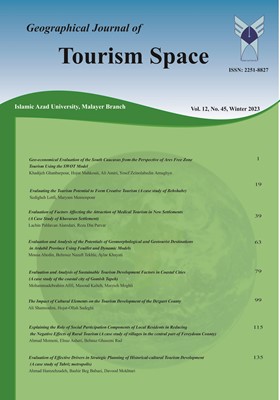-
-
List of Articles
-
Open Access Article
1 - Geo-economical Evaluation of the South Caucasus from the Perspective of Ares Free Zone Tourism Using the SWOT Model
Khadijeh Ghanbarpour Dahchahi Hojat Mahkoei Ali Amiri Yosef Zeinalabedin -
Open Access Article
2 - Evaluating the Tourism Potential to Form Creative Tourism (A case study of Behshahr)
Sedigheh Lotfi Maryam Momenpour Akerdi -
Open Access Article
3 - Evaluation of Factors Affecting the Attraction of Medical Tourism in New Settlements (A Case Study of Khavaran Settlement)
lachin pahlavan reza dinparvar -
Open Access Article
4 - Evaluation and Analysis of the Potentials of Geomorphological and Geotourist Destinations in Ardabil Province Using Feuillet and Dynamic Models
mousa abedini Behrouz Nezafat Aylar Khayati -
Open Access Article
5 - Evaluation and Analysis of Sustainable Tourism Development Factors in Coastal Cities (A case study of the coastal city of Gomish Tapeh)
MASOUD KALTEH MOHAMMADEBRAHIM AFIFI Marzieh Moghli -
Open Access Article
6 - The Impact of Cultural Elements on the Tourism Development of the Dezpart County
ali shamsoddini hojat ollah sadeghi -
Open Access Article
7 - Explaining the Role of Social Participation Components of Local Residents in Reducing the Negative Effects of Rural Tourism (A case study of villages in the central part of Fereydoun County)
ahmad momeni elnaz asherigafshe behnaz ghasemirad -
Open Access Article
8 - Evaluation of Effective Drivers in Strategic Planning of Historical-cultural Tourism Development (A case study of Tabriz metropolis)
Ahmad Hamzeh zadeh Bashir Beg Babaei Davood Mokhtari
-
The rights to this website are owned by the Raimag Press Management System.
Copyright © 2021-2025







